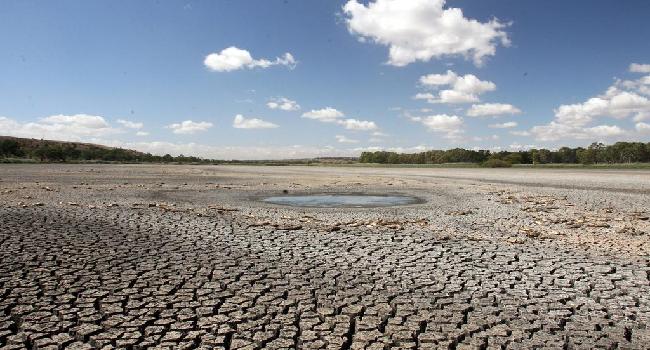
The Australian ecosystem is in decline, biodiversity is threatened and native animal species are at risk of becoming extinct. The key driver for this is the animal agriculture industry and the land clearing that this entails, both past and continuing.
In a submission to a government inquiry into ecosystem decline in Victoria, Vegan Australia has urged the government to recognise that animal agriculture is a significant driver of environmental damage and climate change and that animal agriculture should be phased out to help protect and restore species and ecosystems.
Read the full submission below.
Vegan Australia is pleased to have the opportunity to provide a submission to the Environment and Planning Committee Inquiry into Ecosystem Decline in Victoria. We hope this submission assists the committee in recommending actions to address ecosystem decline and biodiversity loss in Victoria.
Vegan Australia is a national organisation that informs the public about animal rights and veganism and also presents a strong voice for veganism to government, institutions, corporations and the media. Vegan Australia envisions a world where all animals live free from human use and ownership. The foundation of Vegan Australia is justice and compassion, for animals as well as for people and the planet. The first step each of us should take to put this compassion into action is to become vegan and to encourage others to do the same. Veganism is a rejection of the exploitation involved in commodifying and using sentient beings.
The world is currently suffering from an accelerating biodiversity emergency. Species extinctions are increasing, with the UN finding that around one million species are at risk of extinction worldwide. Bushland, forests and wetlands are being destroyed and climate change is affecting ecosystems on both land and sea. These effects also strongly impact Australia, leading to a 2019 Senate inquiry into Australia's faunal extinction crisis. Victoria is fortunate to have a range of ecosystems populated by diverse species, but the same forces damaging worldwide ecosystems are also at work in Victoria.
While there are many drivers of this decline, in this submission Vegan Australia will concentrate on one sector, the animal agriculture industry, that research shows causes a high proportion of damage in a number of ways and yet is often overlooked in inquiries like this.
The UN 2019 Global Assessment Report on Biodiversity and Ecosystem Services puts much of the blame on animal agriculture, saying that the meat industry has a "particularly heavy impact", and identifies animal agriculture as "one of the most significant contributors to today's most serious environmental problems".
Of the major causes of biodiversity loss listed by the report (including the destruction of land ecosystems, overfishing, climate change and pollution), animal agriculture is the primary cause of the deterioration. Fortunately damage caused by animal agriculture may be the easiest to reduce, because animal products can be replaced by plant products with a much lower environmental footprint.
This inquiry into ecosystem decline in Victoria is an opportunity for the community to reflect on the damaging impact of animal agriculture on many aspects of the environment and particularly its contribution to biodiversity loss. The extent of the damage is huge, with over half a billion farmed animals bred, raised and killed for food in Australia every year. The animal agriculture industry occupies over half of the Australian landmass, causes the majority of land clearing and emits a significant portion of greenhouse gases.
By acknowledging the impact of animal agriculture on the environment, this inquiry allows us to consider alternative ways we can obtain food and fibre which do not involve both the suffering of farmed animals and the environmental havoc animal agriculture causes.
The key recommendation of this submission to restore damaged ecosystems is for the government to begin a managed phase out animal agriculture. Acting quickly but in a controlled way will allow the environment to recover while also protecting jobs and the economy.
There are many factors that lead to ecosystem decline. In Australia, the main two are land use by humans (mainly agriculture) and climate change. Others include pollution (land, air and water), hunting, fishing (freshwater and marine) and the impact of introduced species.
These factors impact the environment by causing loss of habitat, species decline, species extinction, soil erosion, salinity, vegetation decline, damage to waterways, weed proliferation, loss of fresh water and forest destruction.
Regarding land use, in Australia 54% of the Australian continent is used for animal farming. Most of this is land used for grazing, along with some land used for growing food for farmed animals.
In other words, over half of the Australian landmass is used to produce animals as food, as shown in the large red area of this pie graph.
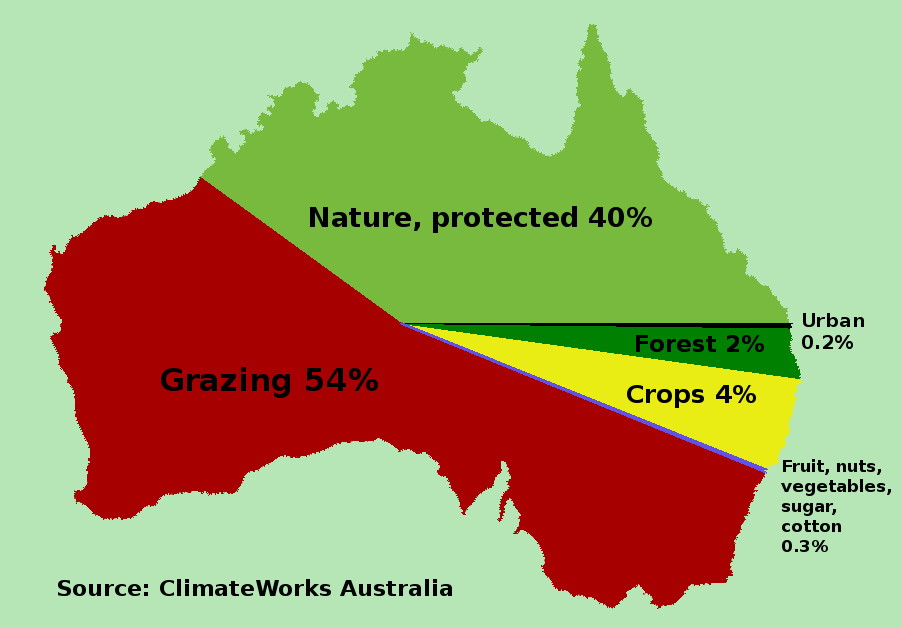
In contrast, only 4% is used to grow crop plant foods, of which about a quarter is used to grow grains and fodder for feeding farmed animals. Fruits, vegetables and nuts use only 0.1%, cotton 0.1% and sugar 0.1%.
The differences are astounding, with a huge amount of land dedicated to raising animals for food, a much smaller part growing crops like wheat and barley, and a tiny amount growing all the fruit and vegetables doctors say we need to eat more of.
As can be seen, growing plants for food is an incredibly efficient use of land.
A key threat to many of Australia's ecosystems and native animals is habitat loss through land clearing, both past and continuing.
A shocking report by WWF-Australia found that millions of native animals are killed each year due to the bulldozing of their forest and woodland habitats. Many die during clearing, crushed by machinery or falling trees. Many others die slowly over days or weeks, from injuries, starvation or exposure. Animals left behind in the cleared landscape are highly exposed and vulnerable to predators.
The report claims that "habitat destruction through tree-clearing probably counts as Queensland's and possibly also Australia's single largest crisis of animal welfare."
Research on soil erosion by the Department of Agriculture in Victoria, found that "under natural conditions, runoff is moderated by vegetation, which generally holds the soil together, protecting it from excessive runoff and direct rainfall." However, excessive clearing, inappropriate land use and compaction of the soil caused by grazing leaves the soil exposed and unable to absorb excess water and leads to erosion, discolouration of water supply and sedimentation of waterways.
To prevent this erosion, the research suggests protecting and re-establishing vegetation, planting trees and "maintaining remnant vegetation along drainage lines and eliminating grazing from these areas."
A report by the Victorian National Parks Association says that "Victoria's natural habitats are on their knees". After 150 years of land clearing, Victoria is the most cleared state in Australia.
The report says that "native vegetation is the best way to maintain habitat for threatened plants and animals. Places with remnant native vegetation support a higher diversity of species than areas that have been revegetated." Victoria continues to clear significant amounts of remnant native vegetation.
Another report, by the CSIRO, states that "Land clearing, primarily for agriculture, is perhaps the single most important cause of environmental degradation, loss of species, and depletion of ecological communities."
The extent of land clearing in Victoria is made clear by the two maps below. The first map shows Victoria's pre-1750 vegetation types and the second map shows the current native vegetation extent. The white areas in the second map show how much land has been cleared of native vegetation. The main use is for animal agriculture.
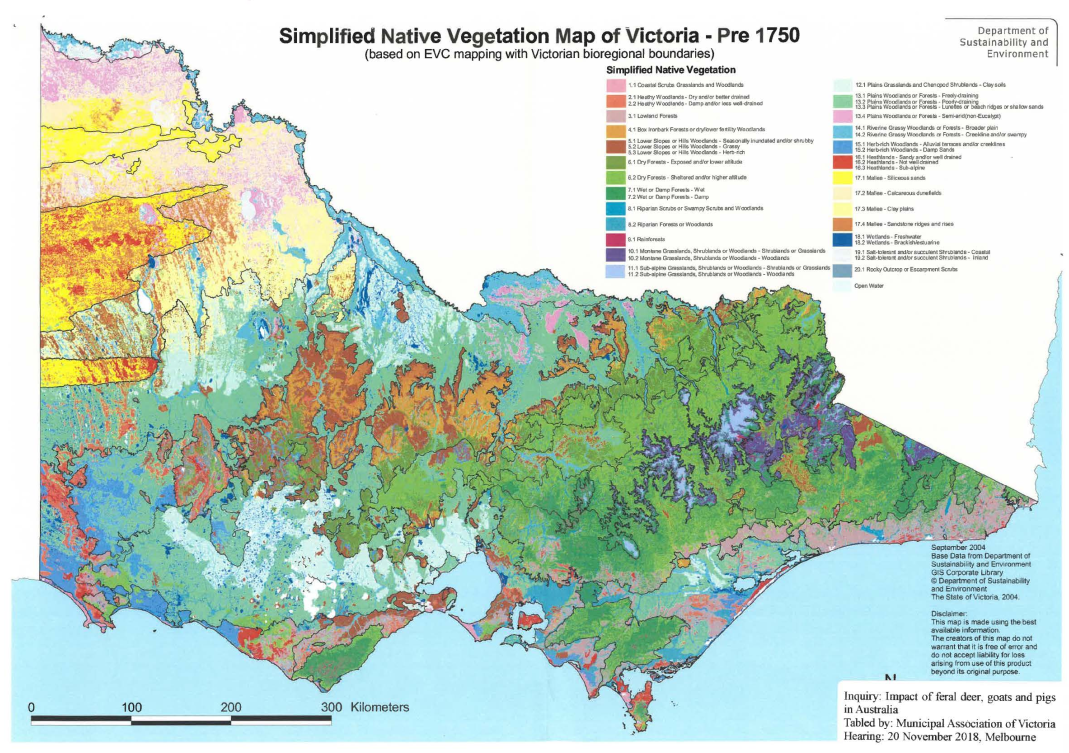
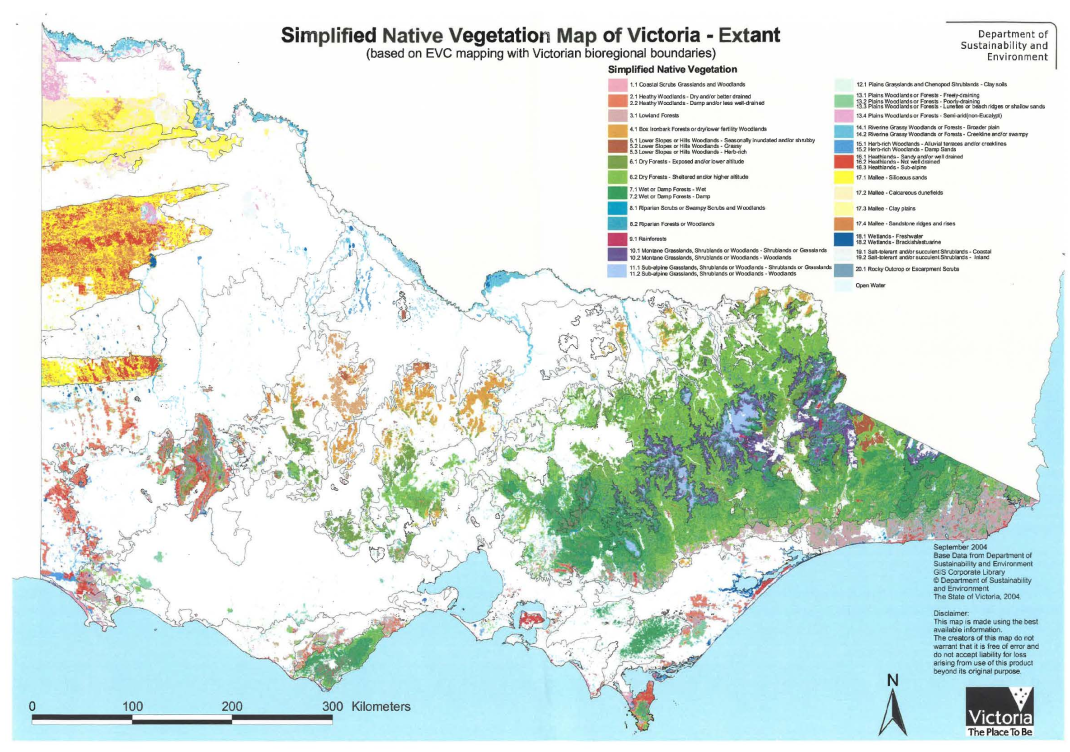
Animal agriculture is the key driver for habitat clearing and destruction in Australia. In Victoria, the most common land use is grazing animals on modified or irrigated pastures, making up about 34% of the state. Additional land is used for growing feed for these animals as well as intensively grown animals.
As the Beyond Zero Emissions Land Use Report says "Since colonisation Australia has seen more biodiversity loss than any other continent and this rate is still one of the highest globally. Deforestation and grazing pressure are the major threats to biodiversity, and cause stress to a range of ecological communities across the continent."
As can be seen from Figure 2.6 of the BZE Land Use Report, much of Victoria has been impacted by grazing.
Native vegetation is still being cleared for agriculture in parts of Australia and although it continues in Victoria to some extent, much of the state has already been cleared.
While animal agriculture uses about 34% of Victoria's land mass, plant farming uses 22%, plantation forests 2.5%, urban development 4%, rural residential 2.5% and mining 0.2%. The main driver for past and current land clearing in Victoria is animal agriculture.
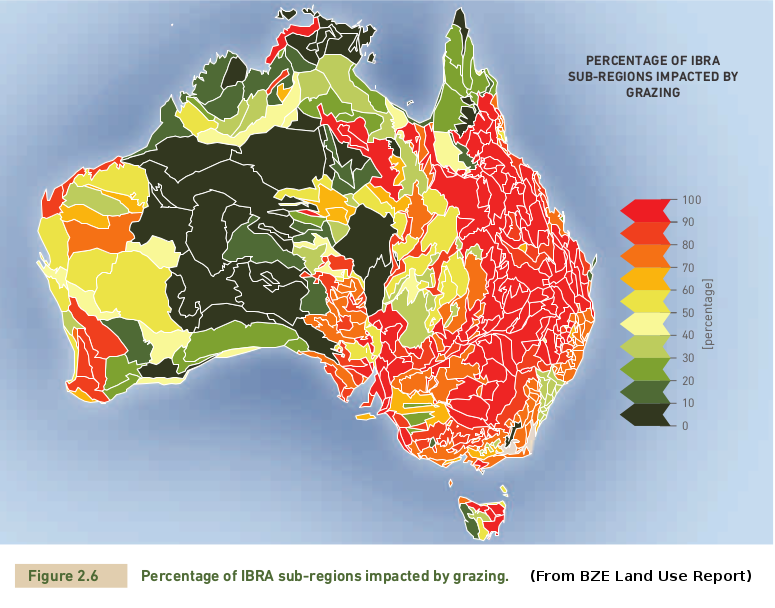
The committee has been asked to inquire into the decline of Victoria's ecosystems and pressures on endangered species. One of the key threats is climate change, which will have a disastrous effect on animal species as well as plant species and humans. Some have called the current climate emergency the "Sixth Mass Extinction". So to protect our native fauna from extinction we need to urgently tackle the climate crisis.
Animal agriculture is the leading cause of climate change. In Australia, animal agriculture emits about 50% of all greenhouse gases, when accounted over 20 years. Animal agriculture produces greenhouse gases through land clearing for grazing, methane produced by cows and sheep and emissions from manure.
In their greenhouse gas calculations, the IPCC and other international environmental organisations use warming potentials (GWPs) of greenhouse gases using a 100-year time frame. The decision to use a 100-year time frame is arbitrary. The IPCC states that "There is no scientific argument for selecting 100 years compared with other choices. The choice of time horizon is a value judgement." The convention to use a 100-year time frame was decided several decades ago, before the urgent need to avoid climate-system tipping points was understood. Given the urgency of the emissions reductions required to avoid catastrophic temperature increases, 20-year global warming potentials are much more relevant. Over 20 years, the global warming potential of methane is about 5 times higher than over 100 years. Animal agriculture is the largest source of methane and so if we measure the impact of sectors using a 20-year time frame, the climate impact of agriculture is significantly higher.
The IPCC and other groups also do not take into account the impact of short-term gases on global warming. In the short time we have available to overcome climate change, the global warming potential of these short-lived gases becomes much more significant. Most of these gases are emitted by animal agriculture.
When 20-year global warming potentials are used and short-term gases are included, we find that animal agriculture is responsible for about 50% of all greenhouse gases, both in Australia and worldwide.
Methane stays in the atmosphere on average about 12 years. This means that reductions in methane emissions will cause more immediate cuts to global warming than reductions in carbon dioxide emissions. Carbon dioxide can stay in the atmosphere for over 100 years, so even if carbon dioxide emissions (from, for example, burning fossil fuels) were reduced now, it would take many decades for this to have an effect on global warming.
Once we understand that animal agriculture is a major cause of global warming, a simple, effective and relatively quick solution becomes clear. By abolishing the use of animals for food, we not only act ethically for the animals, we also help slow and eventually reverse global warming.
At an individual level, the single best thing you can do for the environment is to live vegan. At a societal level, the best thing we can do is to phase out the use of animals in the agriculture industry.
Seriously tackling climate is the only hope of protecting Australia's native animals and humans.
As mentioned in the Introduction, the UN Global Assessment Report on Biodiversity and Ecosystem Services identifies the animal agriculture industry as "one of the most significant contributors to today's most serious environmental problems" including the risk of extinction of one million species worldwide.
The report was released by IPBES, a UN organisation with over 100 member countries, and also found that:
Note that the 18% figure for greenhouse gas emissions from animal agriculture is determined using a 100 year GWP time frame to compare methane and carbon dioxide. Using a 20 year time frame (much more relevant to the current climate emergency), the figure is about 50%. That is, about half of the world's greenhouse gas emissions are due to the animal agriculture industry.
As well as agriculture, the report also lists climate change, pollution and invasive species as damaging to nature, but these have had a relatively low impact compared to the surge in agriculture (mainly animal agriculture) and fishing which are the primary causes of the deterioration.
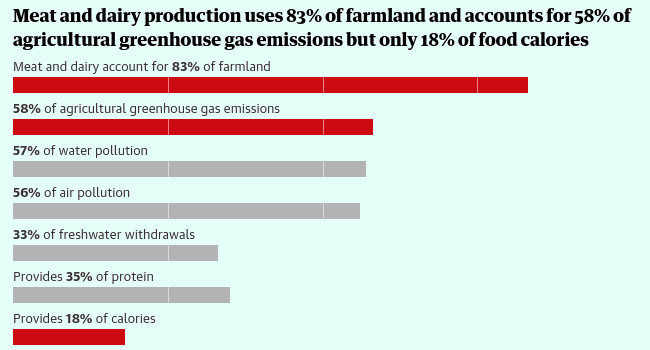
To help reverse some of this damage to the environment, the report recommends that meat consumption be reduced by changes in diet. It suggests that reducing meat consumption in higher-income countries would yield the largest potential gain for the environmental and health benefits.
It suggests "improvements in consumption patterns can likely be achieved by reducing subsidies for animal-based products, increasing those for plant-based foods, and replacing ecologically-inefficient ruminants (e.g., cattle, goats, sheep). Research and development of plant-based meat substitutes is also a growing phenomena and potential solution." It also suggests that meat prices are kept artificially low, which can increase consumption.
The report mentions that another driver for higher meat consumption is its promotion via advertising, which promotes images of identity, such as masculinity and national and cultural identity. "Given the central role of advertising and marketing in boosting production, policies might seek to rein in the reach of advertising, particularly to children and for resource-intensive products" (such as animal products). The report suggests that regulating the advertising of animal products could reduce their consumption and hence improve the sustainability of food.
The report notes that reduced demand for animal products can achieve multiple goals, such as greenhouse gas emission reduction, food security and biodiversity protection.
While the report does not call for a vegan diet, it does suggest that the less meat, dairy and egg in a diet, the better for the environment and for health. Some scenarios mentioned in the report call for 50% less meat consumption. Regarding the environment, the best future scenario beneficial for biodiversity envisioned by the report includes "a shift in diet towards less meat." It also states that "significant reduction in consumption of meat and eggs means that less agricultural production would be required, thus reducing associated biodiversity loss." Regarding health, the report notes that "diet related disease is the leading cause of premature mortality." and "increased consumption of fruits and vegetables is associated with reductions in various diseases such as cardiovascular disease."
In other words, the report is consistent with Vegan Australia's recommendation to phase out animal agriculture.
For decades, hundreds of exotic plant species have been introduced in Australia as feed for animal agriculture and have now become invasive weeds which threaten the environment, cause habitat loss and threaten biodiversity.
One such species is Gamba grass which was originally introduced to Australia as a pasture species for cattle. It is now a significant invasive week in several parts of Australia and increases the frequency and intensity of wildfires and competes with native grasses. See the ABC News article 'Indigenous rangers dismayed as NT Government allows cattle station to graze gamba grass weed'.
By ending animal agriculture, we will not only free up land needed for biodiversity and end the suffering of over half a billion farmed animals every year, but also begin to reverse the damaging impact of invasive pasture grasses.
By removing animals from agriculture, a large proportion of land currently cleared for animal agriculture will be freed up. This will allow regrowth and reforestation which will have many environmental benefits, including strengthening ecosystems, increasing biodiversity and allowing endangered species to recover and possibly preventing extinctions in the future.
Actively revegetating cleared land or allowing it to regenerate naturally will protect soils and prevent erosion, thus producing cleaner water.
Other ways to use the land that will become available when animals are removed from agriculture include:
Carbon farming would enable the land use sector to become a sink for emissions from other sectors, such as power generation and transport.
Only a few possibilities are covered here as this is a large and complex task, with many options and which will require further research. The skilled and knowledgeable rural workforce will be a crucial asset in making this change.
The economic impact of removing animals from the agricultural system will not be as significant as many people imagine. The animal agriculture industry is a relatively small part of the modern Australian economy. It currently contributes about 1.2% to the Australian GDP and employs less than 1.5% of the Australian workforce. For Victoria, animal agriculture contributes about 1.7% to economic output and employs about 1.7% of the workforce. Compared to industries like manufacturing (18%) and construction (12%), the animal agriculture industry is smaller than almost every other industry in Victoria.
Any negative economic impacts of phasing out animal agriculture should be carefully managed to avoid dislocation, by reskilling workers and reusing land for other purposes, such as carbon farming, biochar production and revegetation as described above. Developing the plant-based alternative industry in Victoria will increase and diversify employment opportunities.
Vegan Australia's recommendation to phase out animal agriculture implies a shift to a plant-based diet for Victorians. Nutritional science shows that humans have no need for farmed animal food products. In fact, there is a solid body of peer-reviewed scientific evidence to confirm that it actually benefits human health to consume a primarily plant-based diet. Changing to a plant-based diet can help people live a longer, healthier life, and significantly reduce risk of falling victim to many of the serious health threats facing Victorians today.
The Victorian Government's Independent Expert Panel report on Interim Emissions Reduction Targets for Victoria notes that "literature is also emerging to indicate that reduced consumption of meat and of other animal products (which are generally emissions-intensive) can produce health benefits." and acknowledges that "reduced consumption of animal products would provide further health benefits."
The Victorian Government's Better Health Channel (26) states that vegan diets "can provide many health benefits, such as a reduced risk of chronic diseases, including obesity, coronary artery disease, hypertension (high blood pressure), diabetes and some types of cancer". It also states that vegans "have lower rates of illness and death from a number of degenerative diseases" and that vegan diets "are appropriate for all stages of a person's life".
Australia's peak health body, the National Health and Medical Research Council, recognises that a vegan diet is a viable option for all Australians. Australia's top health experts agree with those in other parts of the world that well-planned vegan diets are safe and healthy for all age groups. The Australian Dietary Guidelines state that alternatives to animal foods, such as nuts, seeds, legumes, beans and tofu, can "increase dietary variety and provide a valuable and affordable source of protein and other nutrients found in meats."
According to the US Academy of Nutrition and Dietetics, "Appropriately planned ... vegan diets are healthful, nutritionally adequate, and may provide health benefits for the prevention and treatment of certain diseases. These diets are appropriate for all stages of the life cycle, including pregnancy, lactation, infancy, childhood, adolescence, older adulthood and for athletes."
Not only are animal products unnecessary for optimal health, an increasing number of nutritionists and health professionals are acknowledging animal products are harmful to our health. This is supported by decades of good research. A healthy vegan diet helps reduce the risk of heart disease, stroke, cancer, obesity, and diabetes, some of Australia's top killers. The World Health Organisation has stated that processed meats such as bacon cause cancer and the red meat is a probable cause of cancer.
A recent issue of the Medical Journal of Australia, dedicated to the question "Is a Vegetarian [including vegan] Diet Adequate?", included the following statements. "A varied and balanced plant-based diet can provide all of the nutrients needed for good health." "Most vegans meet the recommended daily intake for protein." "Vegan diets generally contain just as much or more iron than mixed diets containing meat." "BMI and obesity was lowest for vegans."
The China Study by T Colin Campbell is one of the most comprehensive studies on nutrition ever done. Campbell provides compelling evidence linking animal products to disease, including cancer, heart disease, osteoporosis, diabetes, etc.
By encouraging a transition to a plant-based diet, the Victorian Government will not only be acting to reverse ecosystem decline in Victoria, but also aligning these actions with the State's other goals, such as responding to the climate emergency, improving public health, developing new industries and creating jobs.
We urge the Environment and Planning Committee to recognise that animal agriculture is a key threat to ecosystems in Victoria and to take this into account when making the inquiry's final report.
The challenge of ecosystem decline must be met quickly and effectively in order to avert potential catastrophic effects. To help address this challenge, Vegan Australia makes the following recommendations.
Phase out animal agriculture over 10 years: Vegan Australia has consistently called for the phasing out of animal agriculture. This will allow damaged ecosystems to be restored and biodiversity to improve. Also, the elimination of greenhouse gas emissions from animal agriculture, in conjunction with efforts to substantially reduce fossil fuel emissions, will give us the best chance of avoiding climate-system tipping points and averting the worst effects of climate change. Finally, a corresponding improvement in diet will lead to a lower risk of many chronic diseases.
Ensure a just transition: The transition to an animal-free agricultural system needs to be managed so that living standards are maintained and there is enough healthy food for everyone. Any negative economic or employment impacts should be minimised and any costs should be borne by the community as a whole. The broader society has an obligation to share the responsibility for this shift, so the burden of the economic costs does not fall solely on rural communities.
Vegan Australia proposes a 10 year phase-out period. This period will allow time for adjustments in employment and investment. We recommend that the government consult with experts and workers to plan a controlled phase out of animal agriculture, carefully managing it to allow the environment to recover while also protecting jobs and the economy.
Changes to land use, such as regrowth and reforestation, will continue far into the future. It is important that these changes be protected. Again the responsibility to manage these risks lies with society both now and in the future and not just with individual landholders.
As with any significant change in the economy, the transition will have real impacts on some individuals, families, communities and businesses. It will be important for the government to build on existing best practice to support impacted individuals and ensure a just transition.
Remove subsidies from animal agriculture and give assistance to plant farming: In order to meet this 10 year time frame, Vegan Australia recommends the immediate removal of all subsidies currently given to animal agriculture, and the redirection of these funds to plant farming. In particular, transitional assistance should be given to farmers to switch from animal agriculture to other uses of the land, including plant farming, reforesting, habitat protection and carbon farming.
Cease land clearing: A cessation of land clearing would maintain habitat for threatened plants and animals, support biodiversity, reduce erosion and prevent greenhouse gas emissions.
Incentivise tree planting: Tree planting schemes should be encouraged, as suggested by the Victorian Government's Independent Expert Panel report on Interim Emissions Reduction Targets for Victoria as part of its support for the development of negative emissions technologies. This should include large-scale afforestation and reforestation projects managed by the Victorian Government.
Revegetate land currently used for animal agriculture: The revegetation of land would act as a significant carbon sink, as well as improving biodiversity and other markers of environmental health. Some work has been done in this area already, and that that work has the potential to be expanded drastically. See Vegan Australia's research paper "Moving to a vegan agricultural system for Australia". Efforts to sequester carbon by protecting, restoring or regenerating vegetation should be encouraged and supported through access to carbon offsets or government procurement.
Helping endangered ecosystems in this way may have notable social benefits as well. Researchers at ANU have found that landholders who are engaged in environmental programs suffer fewer problems with mental illness.
Educate the public about healthy vegan diets and the damage caused by animal agriculture: The Victorian Government's Independent Expert Panel report on Interim Emissions Reduction Targets for Victoria lists one of the main drivers of greenhouse gas emissions as "rising food demand with beef cattle being the biggest contributor of agriculture emissions, followed by sheep and pigs."
The government needs to act on this evidence to drive down demand. A concerted effort should be made to educate the public about plant based nutrition and encourage the adoption of healthy vegan diets. This effort should take a whole of government approach and include community groups such as Vegan Australia. The public should be educated about how consuming animal products can increase the risk of many serious chronic diseases, how to eat healthily on a vegan diet and the health benefits of a balanced vegan diet. The Victorian Government should also educate the public about the impacts on the environmental (biodiversity loss, land degradation, climate change, etc) of animal agriculture and the ethical aspects of animal use,
Include 20-year GWP figures in future climate change publications: In order to ensure that the public, and lawmakers, are properly informed about the true impacts of agriculture (and other industries) the 20-year GWP figures should be included alongside the 100-year GWP figures along with an explanation of how they differ. This is known as "dual term greenhouse gas reporting". This two-value approach, which indicates the effect over two different time horizons, is suggested by a number of studies. Providing the 100-year figures alone, without any explanation of the underlying assumptions used to arrive at this figure, ignores the potentially disastrous effects of climate-system tipping points, and constitutes a failure to properly inform the readers of these documents. To increase transparency, Vegan Australia also recommends that the Victorian Government urge other organisations and governments, nationally and internationally, to adopt dual term greenhouse reporting in their publications.
The aims of Vegan Australia are to help bring about a world where people respect the rights of animals to their own lives, bodies and freedom and where animals live free from human use and ownership. In this submission we recommend that animal agriculture be recognised as a significant driver of environmental damage and climate change and that animal agriculture be phased out over a 10 year period to help protect and restore species and ecosystems.
Greg McFarlane
Vegan Australia
Unsubscribe at any time. Your details are safe, refer to our privacy policy.
© Vegan Australia | Registered as a non-profit charity by the ACNC | ABN 21 169 219 854
Notifications